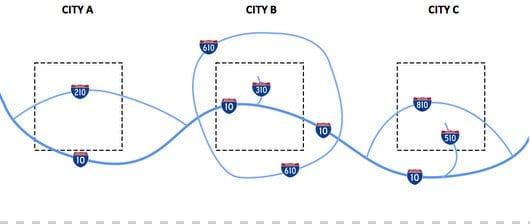How does Interstate Highway system in America work ? Exits, Numbering ?

When I first came to America, I had challenges understanding the interstate highway system. I would constantly run into questions like, why some interstates were numbered with 3 digits, where as some of them were numbered with 2 digits? Odd numbers vs. Even numbers? What is an exit and how does it work? Some of these things are very interesting and can be helpful sometimes when you do not have a GPS …This article will focus on some of the fundamentals of Interstate system in USA and some tips for you to drive according to rules.
What are Interstate Highways in USA ? How does the highway system work ? Exits ?
As the name signifies, interstate highways are nothing but highways between states connecting major cities in a state with major cities in other state. In fact, it is like a big network interconnecting various cities of all states in USA. They are often called as Freeways or expressways. These interstate highways do not have any traffic signals or traffic lights. So, you can basically drive freely without any stops….You can get on and off from these high ways using exits. An exit is nothing but a path, which is a lane, branching out from freeway….Exits enable vehicles to get off the interstate without stopping your vehicle ….You just have to slow down when taking an exit. Typically exits are often one mile apart, but if you are in a big metro city they are much closer with A, B, C D and other letters assigned to the exit number… Also, the exit numbers starts from 1 as you enter a new state and goes up by 1 for every mile until you cross the state. Key thing to note is, every time you cross the state the exit numbers reset and start from 1 or a large number depending on the direction you are going. So, do not need to freak out if you miss numbers at times…
How does the interstate highway system numbering work ?
Typically, major highways interconnecting cities are numbered with 2 digits and few of them with single digit. They are typically less than 100.
- East-West interstate highways are even numbered
- North-South interstate highways are odd numbered.
If an interstate highway is numbered with 3 digits, then it means it is not a primary highway and it is kind of loop (Very important, not to get lost) or connector in a city either diagonally or around a city. They are called Auxiliary interstate highways. You can see the below image.
Sometimes the interstates are also labeled as interstate business routes; it is just a route parallel to the actual interstate, but goes through city or small town. You do not want to get confused and take these during long drives because it will take your time away as these have traffic lights.
USA Interstate Highway system Rules and Information
All interstates have speed limits varying from 50 mph an hour to 75 mph depending on the state and position of the interstate. You have to drive within the speed limit, otherwise you can be pulled over and get a ticket. Read my experience Why NOT to drive over speed limit for consequences. Also, in general slower traffic always stays towards right. Left lane is typically passing lane. Depending on state, it can be emergency or quick passing only lane too ( I was pulled over in Illinois for driving in left lane for 10 minutes continuously) If are going in wrong direction or miss an exit, you should take next exit and then turn around properly, do not try to take short cuts by taking the feeder or small passing lanes between two freeways…they are meant for cops and service vehicles only…be careful. Also, the interstates have zigzag patches or saw kind of patches on the end of the road, they are meant to alert you by making noise if you loose control by sleeping. Coming to shoulder, there is a solid yellow or white line dividing the main free away lanes, do not drive in shoulder they are meant for Cops and service vehicles. Some of you may be used to driving in shoulder in home countries, not here in US.
Do you have any other things to share about Freeways in America or Interstate Highway system in USA ?
References -
http://redbus2us.com
Image Credits :
http://upload.wikimedia.org/wikipedia/commons/0/0a/FHWA_Auxiliary_Route_Numbering_Diagram.svg and
http://digital-artist-toolbox.com/images/signtut%20images/signtut19.gif

 Do you have any trouble remembering dates, phone numbers, PIN's, social insurance numbers and so on? Don’t worry... From a practical perspective, we remember something best if we learn it in a context that we understand, or if it is emotionally important to us, or if we associate/connect it to another meaningful or predominant piece of information or fact. Motivation is also a powerful stimulus to memory effectiveness.
Do you have any trouble remembering dates, phone numbers, PIN's, social insurance numbers and so on? Don’t worry... From a practical perspective, we remember something best if we learn it in a context that we understand, or if it is emotionally important to us, or if we associate/connect it to another meaningful or predominant piece of information or fact. Motivation is also a powerful stimulus to memory effectiveness.
